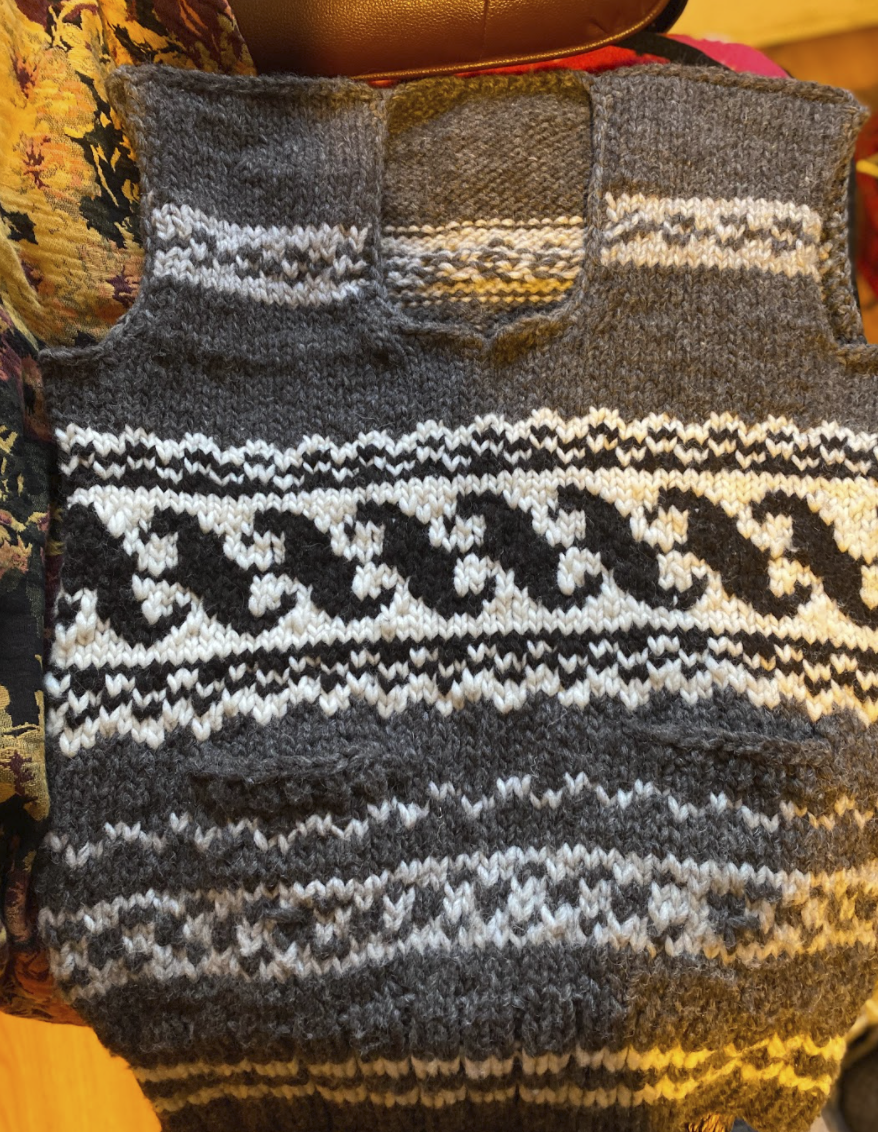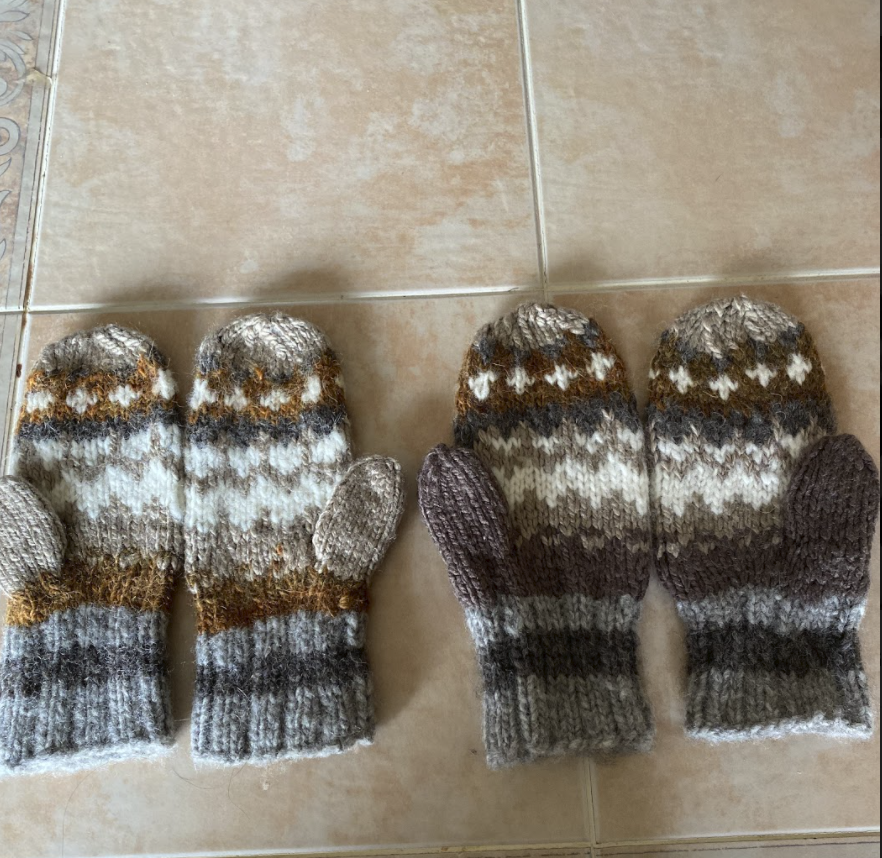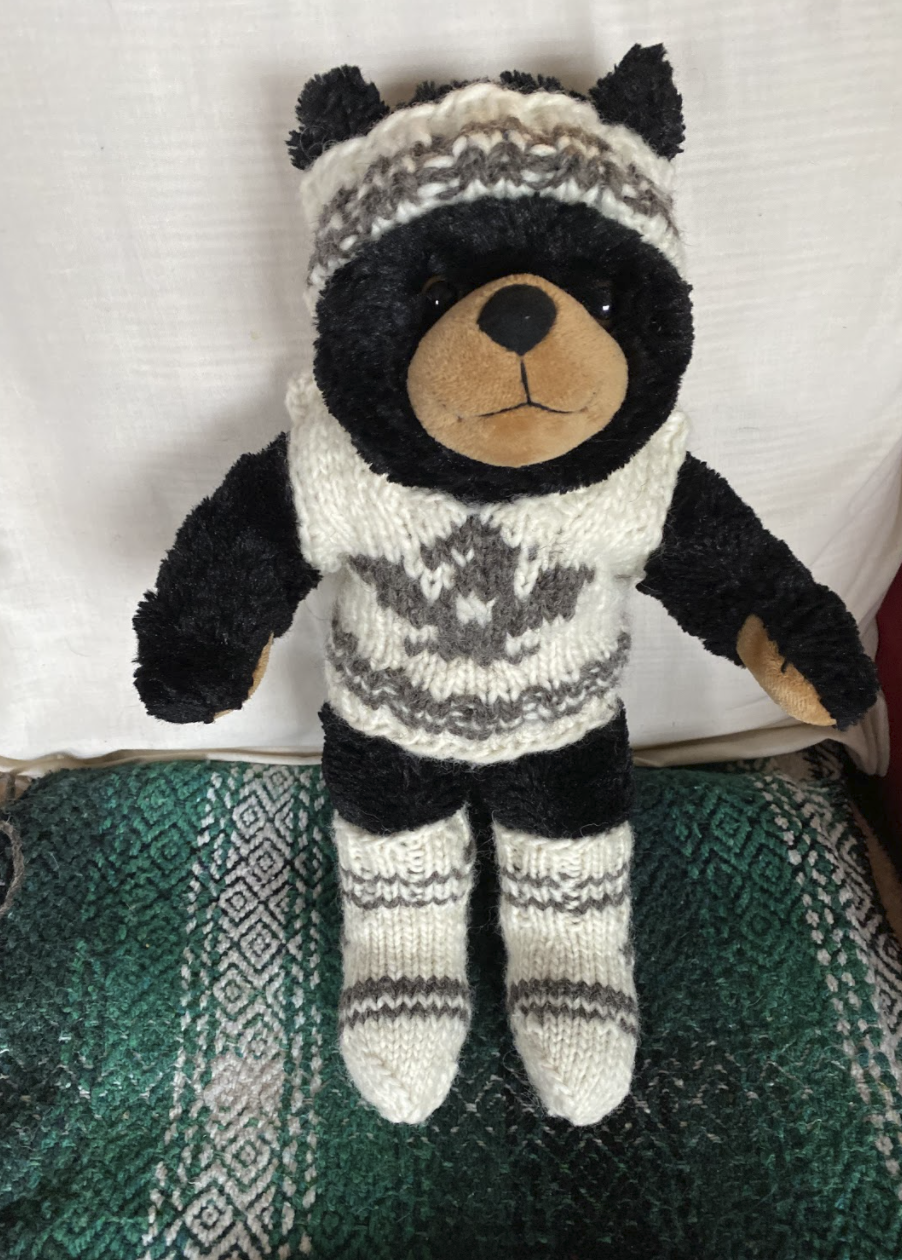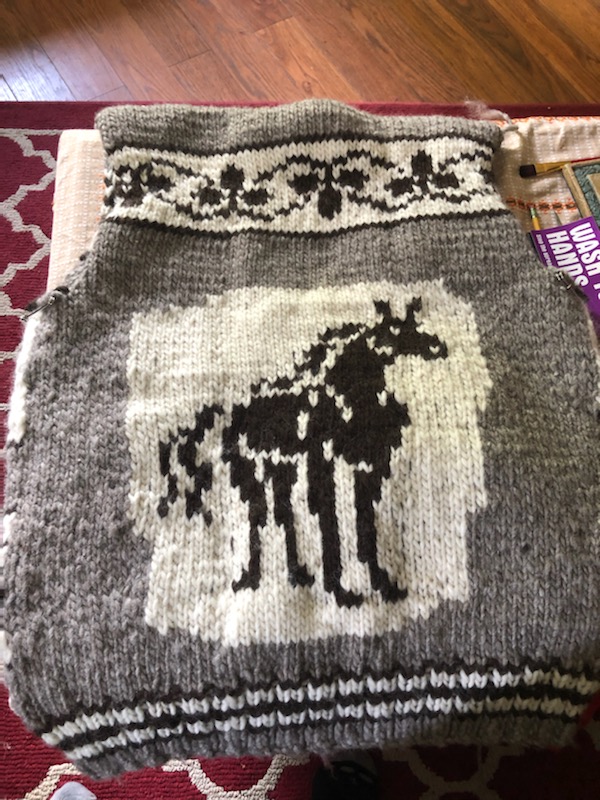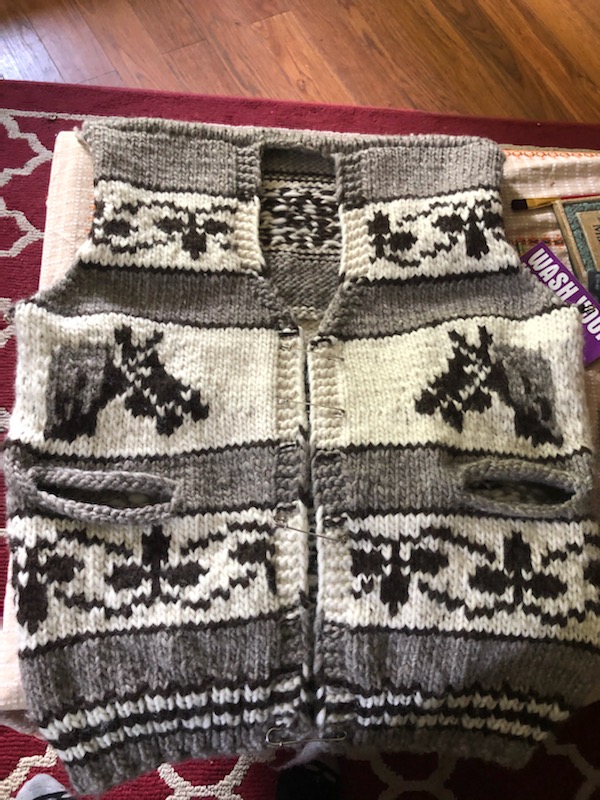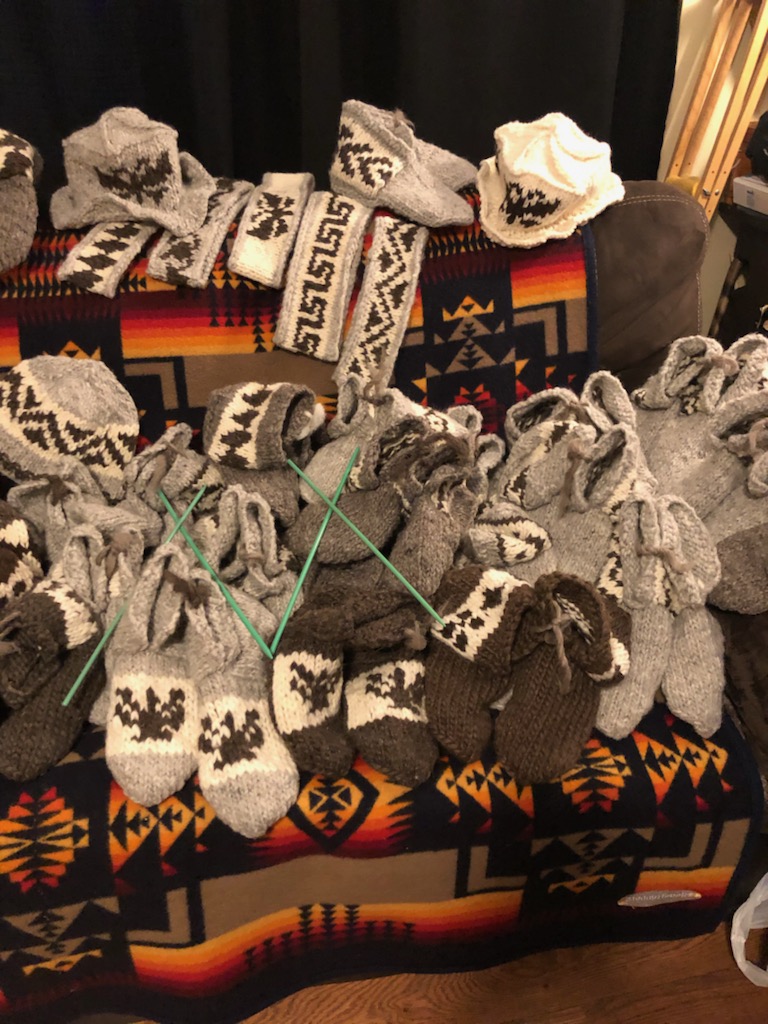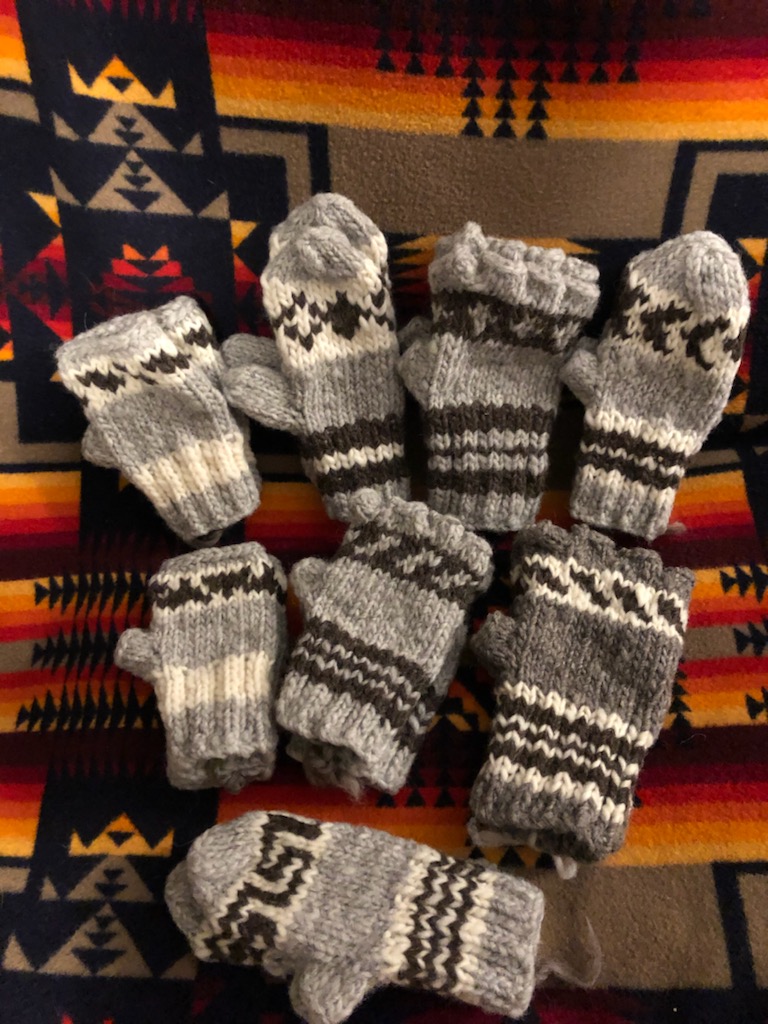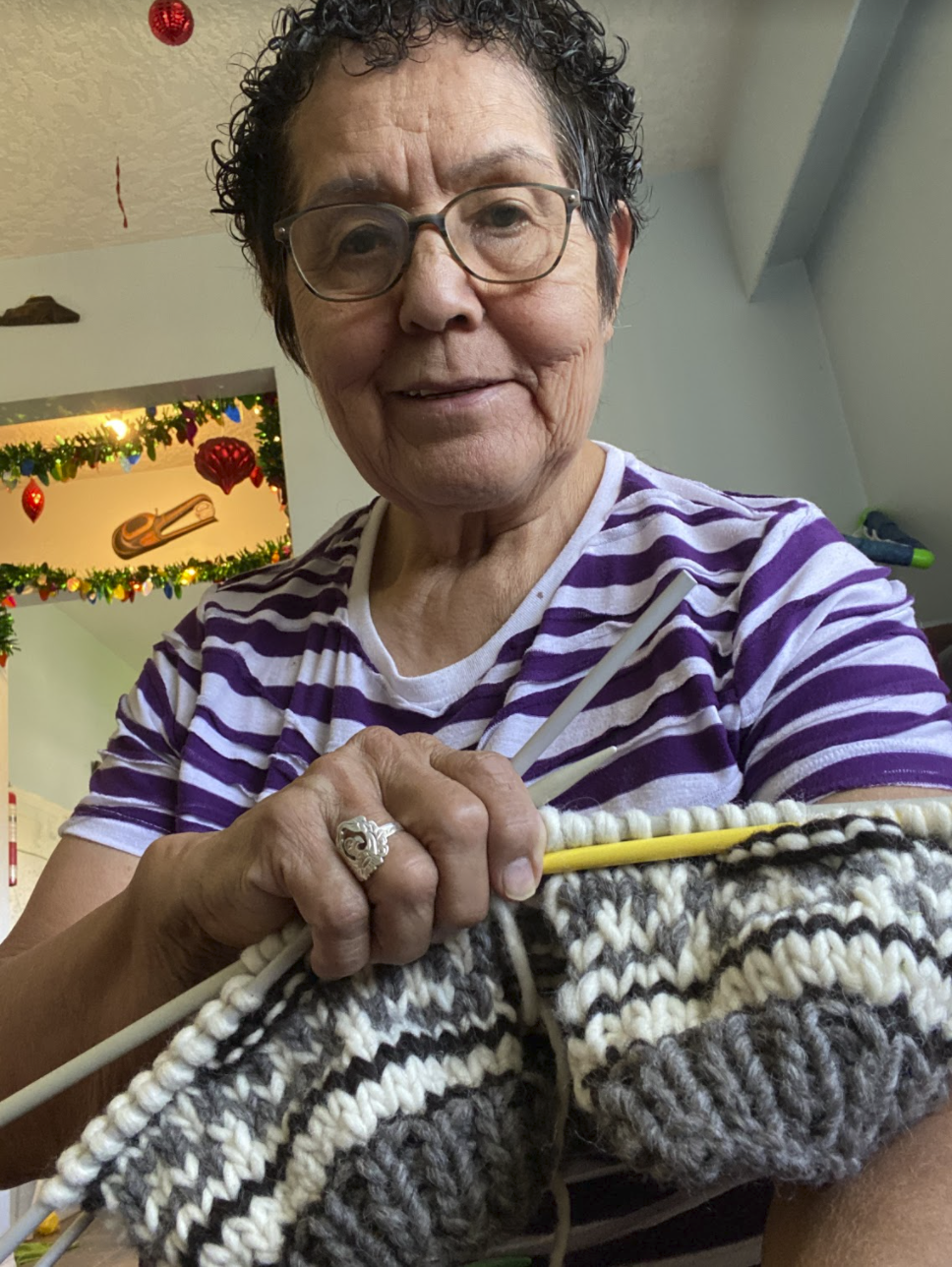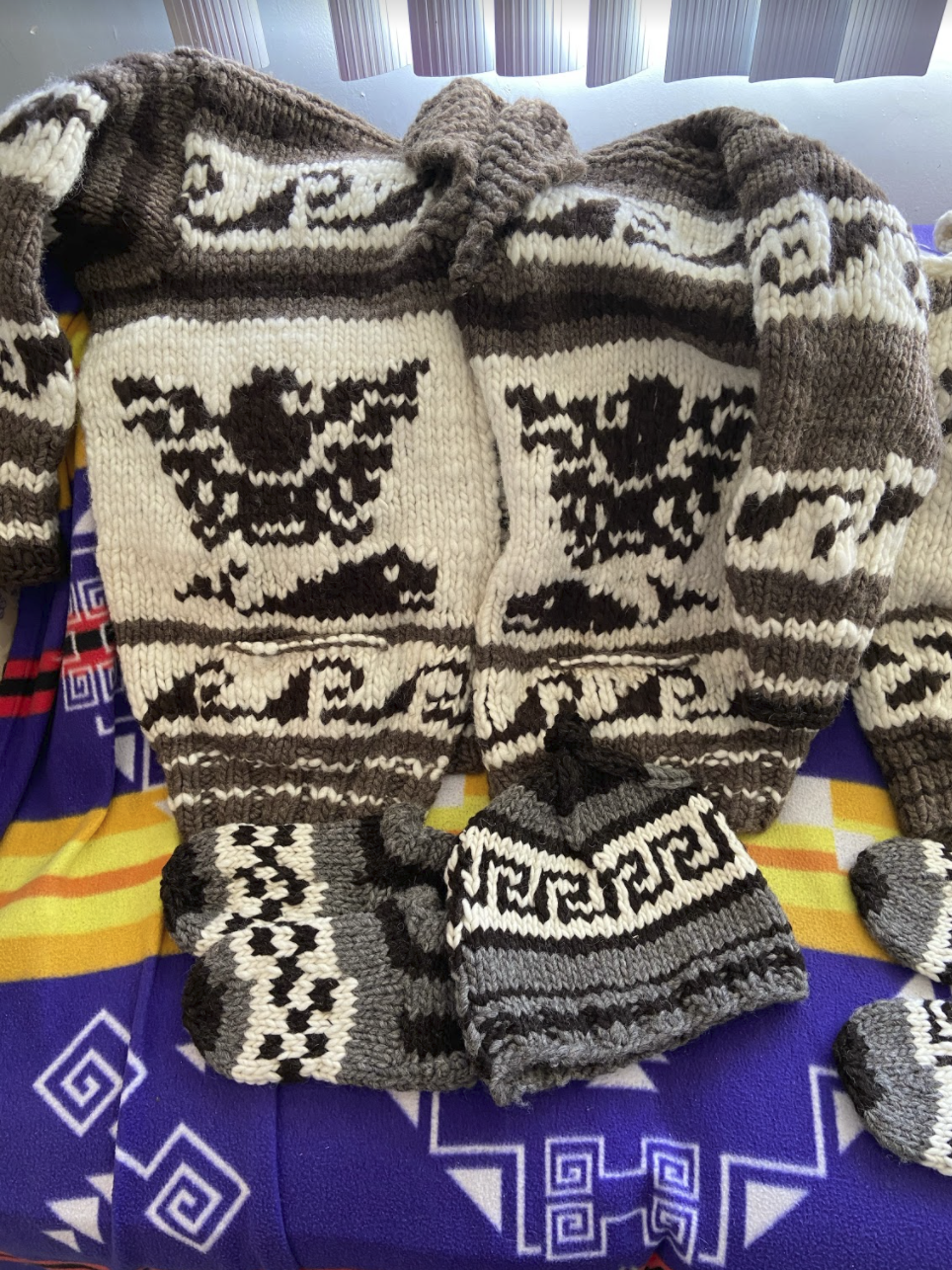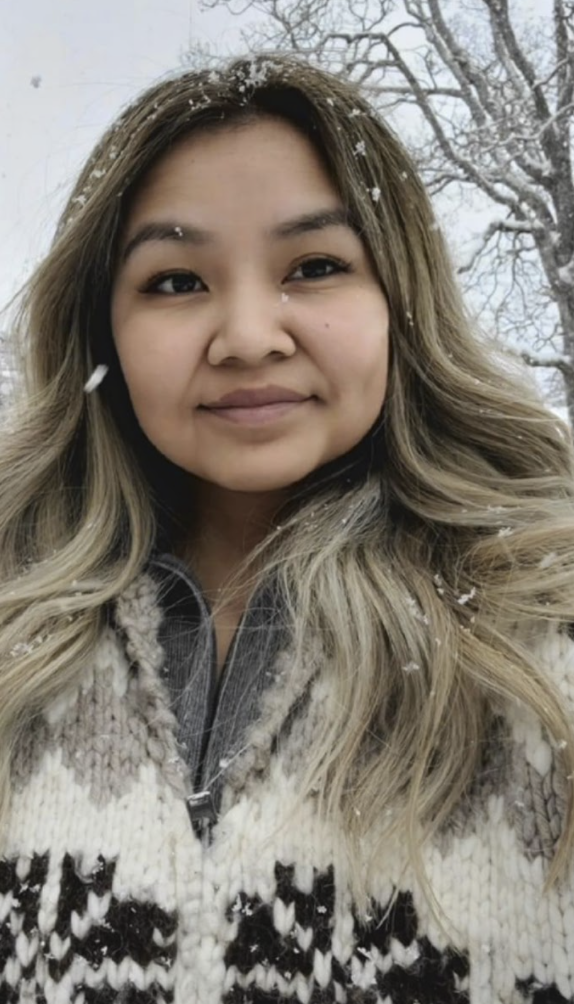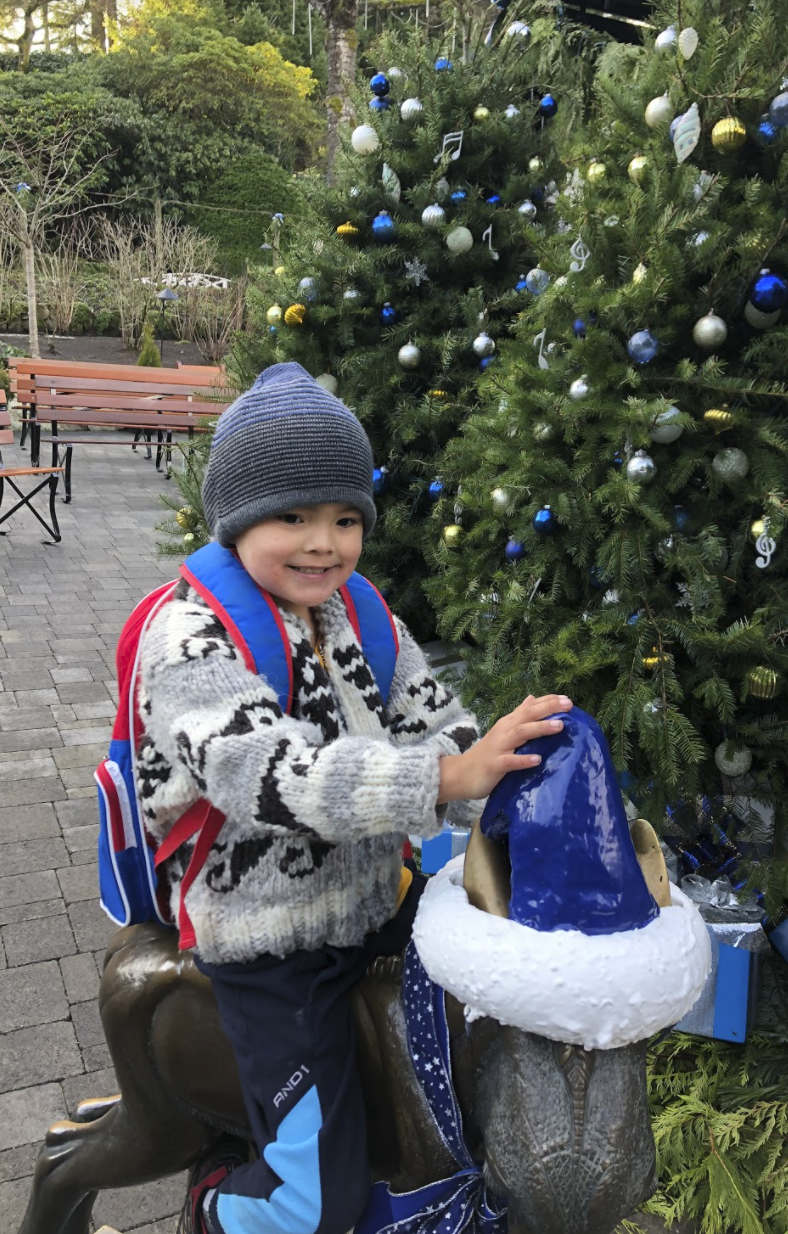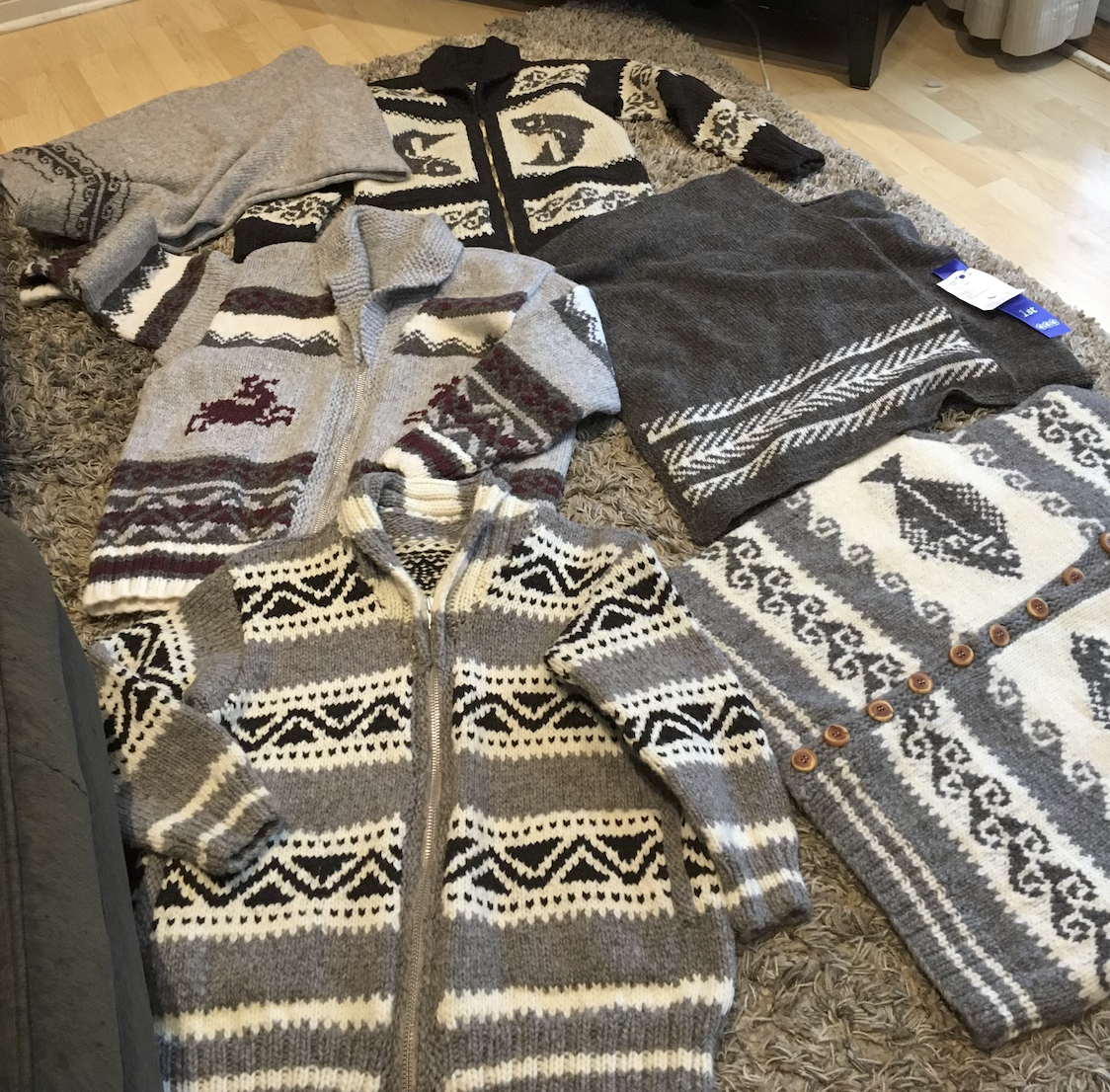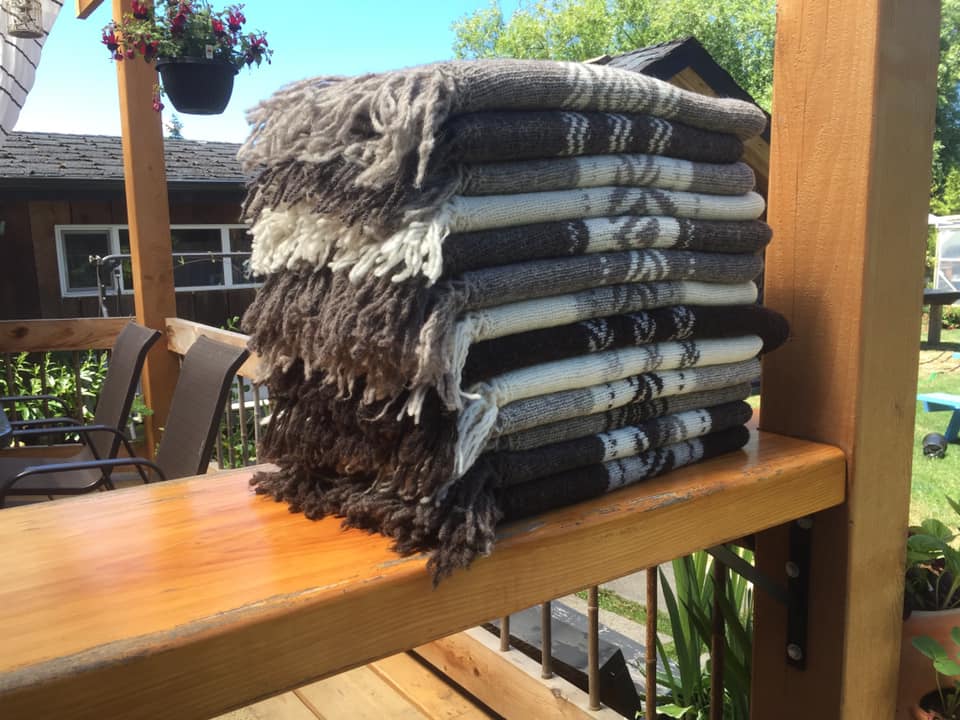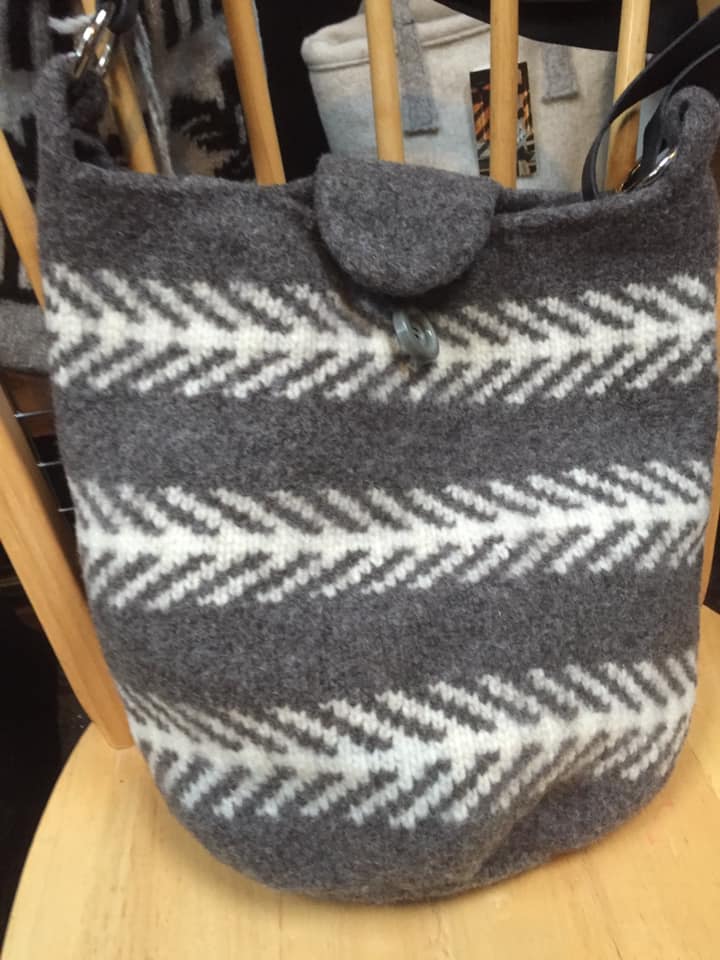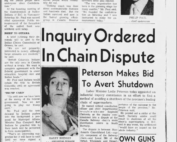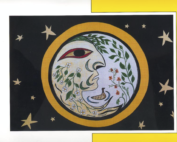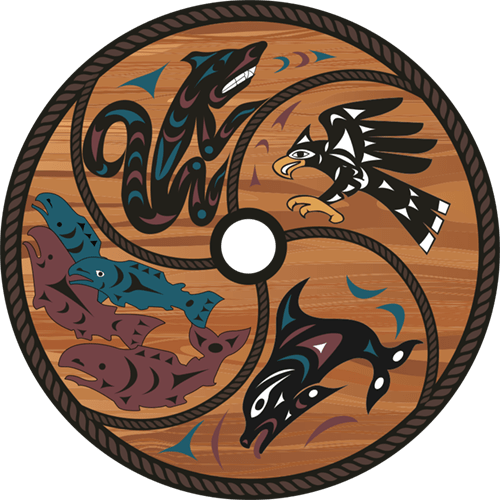Honoring WSÁNEĆ Knitters:
From the 1940’s to 1990’s a large number of W̱SÁNEĆ women knit to feed their families.
As part of WLC’s mission to promote respect for W̱SÁNEĆ culture, this is the second of a three part series celebrating W̱SÁNEĆ knitters.
The first article honoured the knitters who have passed. This feature celebrates some of the contemporary knitters of the community, the details of how knitting has been passed on through the generations, as well as the ways knitting has both changed and stayed the same.
Verna & Joe Ellsworth
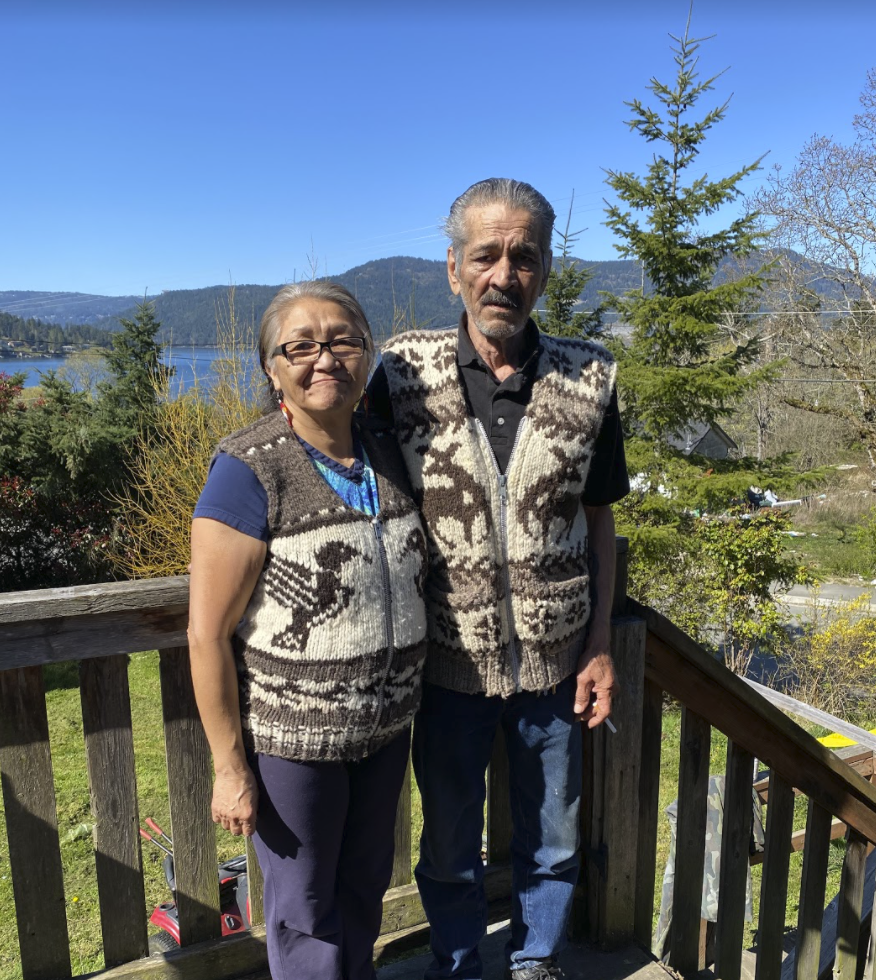
“Knitting connects me to my memories and my journey. I think it’s such a beautiful art,” Verna shares. Her journey with knitting starts with the generations that shared their wisdom with her.
Verna was taught to knit according to the teachings of her family: first, that children have pure minds and are able to absorb learning like a sponge; and, second, that there are times that it’s important to keep busy with skills like knitting, cooking, folding laundry and making your bed. At the age of 15 or 16, Verna was going through a transition, and it was then she was taught to knit.
Verna remembers, “When I was a kid we’d wash the wool, dry it, card it and tease it–take out the burrs and whatever–someone was carded and piling it up in a box, and then my mom and aunt would be spinning. What a long process!”
From 15 to 26, Verna knit on and off until she went into the longhouse at 26. It was there she learned from one of her mentors, May Sam. “My mother used to spin from the sheep. I didn’t learn how to do that, so they brought a spinner to me and May Sam taught me.” Again, in 1983, Verna was going through a spiritual transition and had to learn to spin again. “It wasn’t easy for me, it would be too skinny, and I’d think, oh I don’t like it. But I learned from the action of doing it. The momentum of doing it is how I learned.”
Verna’s husband Joe is originally from California. When he landed here he didn’t have a status card. He only had a landed immigration card and wasn’t able to work. One day he asked Verna to teach him to knit, but she didn’t know how to because he is left-handed. Verna laughs, “He started to learn just by watching me, and then I got the patience to teach him.” From then on, they became a knitting team. Verna spun and Joe would knit two sweaters a week. Verna remembers, “At first, when we had company, he would hide, ashamed because he wasn’t working, until he learned that some of the best knitters are men. Now he’s not ashamed.”
Verna shares, “We use knitting as a way of life. Selling a sweater to buy the wool and buy the meat and bread and keep going.”
Verna went to Camosun College and became a permanent part-time home support resident care aide. She’s also had six children and the whole time she’s continued to knit.
“I keep knitting because I say it doesn’t matter how I live, what I drive or whatever. I will never forget going back to my childhood. Today we are well off. We never called it being poor, but I never forget about how selling that touque and sweater provided me a meal and helped me raise my six kids. My kids say if we had to survive on this, we would starve today.”
Verna also learned how to crochet and make baskets while improving her knitting skills. In addition to learning how to spin from her mentor May Sam, Verna learned to zipper sweaters at Sylvia Olsen’s business, the Mount Newton Indian Sweater Company.
“When I wasn’t doing baskets I went to work in her store and I was able to learn how to zipper sweaters. The love of knitting, I learned that also. You have to love it and you have to have a connection. For me it’s the smell.” The smell brings Verna back to the beginning threads of her journey when she was helping her mother and aunt.
“I would have loved to see more of our young people get introduced to knitting. Knitting connects us, like our history, we have a shared history. And I love it. It’s beautiful. “
When asked if there was anything else she’d like to share for this article, Verna replied “My late mother died in the 1980’s of cancer. It was too late. Go get your checkups, get your pap smears and get your breasts checked. Men too. It’s the responsibility we have to our bodies.”
Shown above : Vest, Mittens and Teddy Bear Outfit knitted by Verna and Joe Ellsworth
Tammy Paul
Tammy Paul learned how to knit in elementary school by helping her mother knit the sleeves and plain sections of the sweaters she was working on.
“When I was young I enjoyed the process of washing, and hand carding, etc. Now I am older, it’s work,” she laughs.
That doesn’t stop her from spinning her own wool though: “I prefer to spin my own because I can get the wool the way I like it, where it’s not too thick, not too thin and just the right tension.”
Tammy really enjoys taking on new knitting challenges. Right now she’s trying new hats with flat tops, gloves with fingers and gloves with finger holes. Tammy won’t necessarily wait until she has an order either, she’ll knit until someone wants to buy her work, or knit for her family. “All my grandnieces got new vests over the pandemic,” Tammy shares.
Like many W̱SÁNEĆ, knitting is a way of life for Tammy and her family: “Me, my mom, my sisters and my nieces knit. I haven’t got my daughter into it yet but I am hoping that will change. If not, I have to teach my son. A lot of my male cousins knit.I taught my partner how to.”
When asked why she still knits, Tammy laughs, “A hobby, for money, I love it. I am knitting right now.”
Shown above, Tammy Paul’s Knitting
Yvonne Sam
Yvonne learned how to knit when she was 8 years old. Her mother, father, aunties and grandmothers all had a part in teaching her. “I made my first toque and gave it to my late grandfather because you’re supposed to give the first one away,” Yvonne shares.
Since that very first toque which took her about a week to knit, Yvonne has progressed to knitting almost constantly to fulfill requests from family members as well as commercial orders. “I can’t do anything without my knitting! When we travel, my knitting bag is the first one in the car and I make sure I have enough wool for the trip. When we went to the canoe races, I had three orders done.”
She remembers fulfilling a rush order for 6 Cowichan sweaters: “I knit non stop and just took cat naps. Three of them were extra large but I still got them all done in two weeks with the pockets and zippers. I wasn’t a very good cook for those two weeks.” Yvonne laughs, “When I was done, I slept for two and half days and I was literally still knitting in my sleep.”
Right now, Yvonne is working on an order for 18 Cowichan sweaters for a commercial customer, spinning her wool and, once the sweaters are done, making sure everything is sanitized. Usually, the sweaters take 3-4 days to dry, so Yvonne uses a small water vacuum to suck the water out and speed up the process.
In addition to selling her work, Yvonne enjoys making her own patterns and spinning her own wool to knit sweaters for her family “My cousin wanted a giant owl and I had to spin finer wool to make it, but 30 years later he still has it.” She laughs, sharing a story about the sweaters she’s made for her husband: “I have made him three sweaters in his lifetime, he lost the first two. One time he went to the bar and saw the bartender was wearing his! The fourth one, well, I just made him three vests. Because the others got stolen.”
When asked if the way she knits has changed since she learned, Yvonne shares:
“One thing I carry is the teachings from my grandmother; you never pick up knitting when you’re mad or sad as you’ll pass it on. Take it easy, make sure you’re strong with the work you do, with the strong belief in your work”
It’s this teaching Yvonne passes on, “I am a grandmother and a great grandmother now. I try to make sure my granddaughters follow those teachings. I am teaching my one granddaughter who will be 12 in October. The 13-year-old is kind of interested but not really. My son Billy is 45 now and he knits faster than I do. My daughter Cathy is 46 and she makes blankets as well as crochets.”
Lavina Olsen:
Shown above: Lavina Olsen holds up her current knitting project
Lavina has been knitting constantly for at least 35 years. She learned from her mother and late mother-in-law. Lavina’s mother was Louise Johnnie, from Duncan who married into Nanaimo reserve. Lavina remembers, “I used to watch my mom. She did all the hard work. She used to wash and spin and I would help her tease, I was about 12.”
Lavina grew up, moved out and then came back and started knitting again seriously at about 23 when she learned how to make sweaters from her late mother-in-law, Virginia Joe. “She had beautiful sweaters. She taught me how to divide and how to do the shoulders and the collar.” Lavina remembers with pride, “I made my first sweater and you couldn’t even put your finger through it, the knitting was so tight. I sold that in Sidney.”
Next, Lavina learned how to make headbands, slippers and socks. “It took me a long time to learn how to make the heel,” Lavina remembers. After a while, Lavina learned how to spin her own wool. “When you’d buy it, it was carded, then I learned how to break it in half, 1/4, ⅛ for that fine spin.”
Lavina’s mother introduced her to buyers that she’s still in contact with. Lavina’s buyers are from Port Alberni to Tofino. For orders from the States, Lavina would go to Vancouver and the buyers would meet her there to pick up her knitting. Some are private wholesalers, others are individual sales. Lavina has made fingerless gloves for fishermen and once she took a bag of her knitting to a museum in Oregon and they bought it all.
In addition to selling her work, Lavina also makes clothing for her family. For her first grandchild, she made a jumpsuit which would now be 25 years old. Over COVID, she made all her grandchildren sweaters and is now working on a sweater for her great-grandson.
Like her mother taught her, Lavina has passed on her knitting knowledge to her two daughters who both knit. “Genevieve Elliott made a sweater for her daughter, she knits to give. Tracy Underwood still knits hats and purses.”
Shown above Lavina’s granddaughter Savannah Wilson in the sweater Lavina made for her. And ȾIOȽŦET / Tyson, Lavina’s great grandson in a sweater she also knit.
Joni Olsen:
Joni has been around knitters and wool her entire life. Her mother, Sylvia Olsen, owned and operated Mt. Newton Indian Sweaters in the 80’s and 90’s and Joni spent a great deal of time in the shop listening to the knitters buy, sell and visit. Although Joni’s mother Sylvia is not First Nations, through her business, Sylvia became very close with many of the local knitters and spent hundreds of hours knitting, spinning wool and putting zippers on sweaters.
Joni’s paternal grandmother Laura was knitting almost every time she would visit. Joni remembers, “I used to sit beside her and wish that I could create like that and have a basket full of wool and needles just like hers. I also always wished for the things that she knit.”
Joni recalls that she was shown how to cast on when she was a teenager and received tips over the years but did not start knitting until she was in her twenties. Joni shares
“I am an intuitive knitter. I have never really been taught, I look at others knitting and then figure it out. Over the years and through trial and error my knitting skills have become much more refined.”
Now, Joni and her mother experiment with different gauges of wool, fulling wool, creating patterns and knitting with machines. Joni makes shawls, toques, hats, sweaters, vests, skirts, bags and even home decor like blankets, ottomans and pillows.
Joni used to travel to art shows with her work, but now she’s building a small shop on her property. About the shop she’s building, Joni shares, “It’s so I have a place for my work and also a space to buy and sell work of other local knitters and artists. I still knit a lot because I love creating beautiful things that make people feel good, but one of my new favorite things is selling wool to other knitters. Knitting is not what I do for a living but it is what I love to do.”
Shown above, some of Joni Olsen’s knitting
Honouring W̱SÁNEĆ knitters
These are the stories of just a few contemporary W̱SÁNEĆ knitters. By continuing to knit today, they are passing on the skills their ancestors developed through decades of strenuous labour which helped ensure W̱SÁNEĆ survival against incredible odds.
A few of the other knitters who we could not reach in time to publish this article are:
Jen Elliott
Erma Smith
Irene Smith
Colleen Paul
Marie Váa
Clarence Dick
Jennifer George
Stay tuned for the next article honouring W̱SÁNEĆ knitters. Don’t miss a thing! Sign up for our newsletter or join us on social media.
RECENT POSTS
How are we doing?
“What she did was knit so we could eat. There were 12 of us and there needed to be a way to supplement my dad’s income. He was a fisherman and logger but the wages weren’t that good. With his work, he paid the bills. With her work, she made the meals. All of her knitting was to put food on the table.” Carl Olsen, remembering his late mother


